
views
X
Research source
Beverly Ulbrich. Dog Trainer and Behaviorist. Personal interview. 30 January 2020.
When your dog barks at another dog, though, this could become problematic and simply annoying. If your dog has made a habit of barking at other dogs, you will need to train him and try different strategies to stop this bad behavior.
Stopping the Barking Through Relaxation
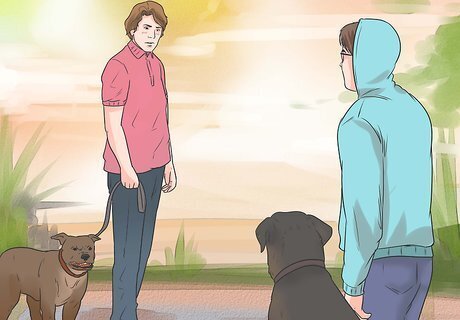
Position yourself and your dog away from another dog. If your dog barks like crazy when he is on the leash or behind a fence, he is experiencing ‘barrier frustration’—he feels frustratingly constrained by the barrier. To start relaxing your dog and easing this frustration, put him on a leash and stand close enough to where he can see another dog, but far enough away so he does not react. Choose an area where dogs normally frequent, such as a dog park or a pet store. There may be some initial trial and error to determine just how far away to initially position yourself and your dog. If you go to a pet store, you may want to stand at the edge of the parking lot or far away on the sidewalk. If you go to a dog park, stand at the edge or in a corner of the park.
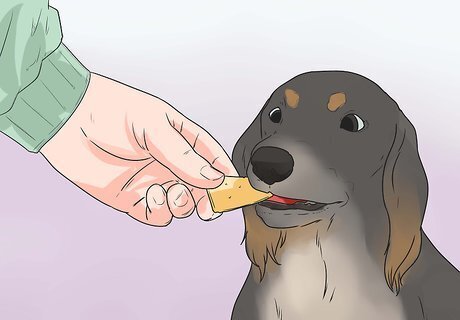
Give your dog treats. When your dog notices another dog, but does not bark or otherwise react, give him a scrumptious treat. Rather than give him a full treat at once, continuously feed him small bits of treats the entire time that he sees, but not does react to, the other dog. The continuous feeding is not only a continuous reward, but can also keep your dog somewhat distracted while another dog is passing by. Discontinue the treats after the other dog has passed by. Remember to reduce the size of your dog’s meals to account for the extra treats you give him during his training sessions. As your training progresses, replace the treats with verbal praise and petting. Watch your dog closely for signs (growling, raising hackles, staring) that he will begin barking. The goal is to give him treats before he starts reacting or barking. With repetition, your dog will probably start looking to you for his treat when he does not bark or react.
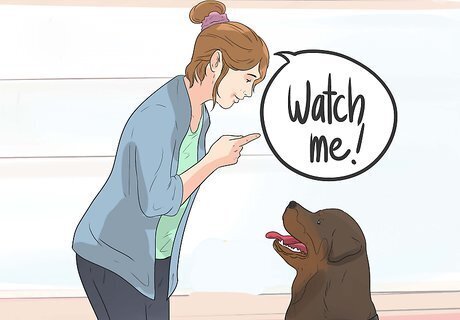
Add in a verbal cue. In addition to giving your dog treats, consider giving him a verbal cue to draw his attention toward you and away from the other dog. Pick a short phrase (‘watch me’) or one-word cue (‘focus,’ ‘look’) and say it each time your dog sees another dog. Say the cue before you give your dog a treat so he can associate the cue with the reward. It is very important for you and other family members to say the phrase or cue consistently so your dog knows when he should not bark.

Move your dog closer. Challenge your dog by gradually moving closer to the other dog (e.g., closer to pet store or dog park entrance). If your dog starts reacting and barking, move back and work on moving more closely again. Try moving forward a few feet or meters per training session. Continue giving your dog treats as before, as long as he does not bark or react. As you move closer, watch your dog's body language to see if it's just being playful or it is aggressive around other dogs. A playful dog might be wagging its tail and bouncing around, while an agitated, aggressive dog might be more stiff and slow and may bare its teeth. You may have to get creative with how you move closer. For example, if you are at a pet store, you may have to reposition yourself on the sidewalk or in the parking lot.
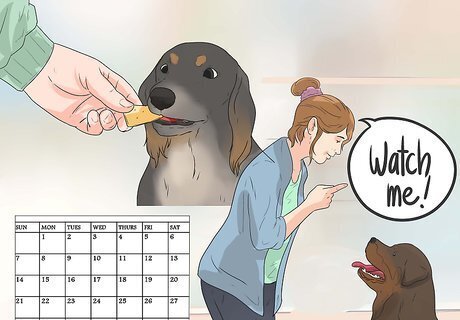
Practice every day. Daily practice is essential to getting your dog to stop barking at other dogs. To keep him interested, limit your training sessions to 5 to 10 minutes. The training sessions should be positive and upbeat, with plenty of positive reinforcement (treats, verbal praise, extra petting).
Stopping the Barking During Walks
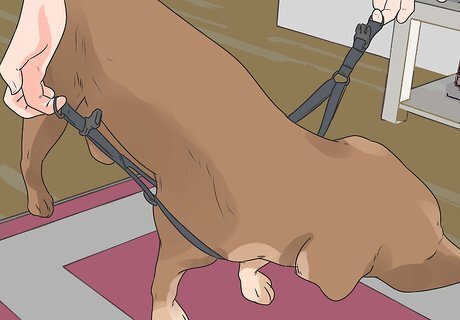
Walk your dog with a sturdy leash or harness. A walk with your dog is supposed to be a pleasant experience, not a battle of wills to keep your dog from barking or lunging at another dog. Having your dog on a good leash or harness will help you control your dog in case he starts barking or lunging. No-pull harnesses are ideal because they will not hurt your dog in case you need to move away suddenly or pull your dog back. Your first instinct may be to keep a short, tight grip to the leash. However, this can make it more likely that your dog will pull. Hold the leash firmly, but not too tightly. Throughout the walk, if you have to move your dog away, be sure not to pull on the leash.
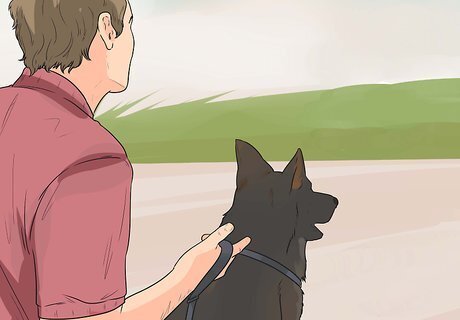
Choose a different location where you can walk your dog. There are many ways to stop your dog from barking at other dogs while on a walk, the simplest of which is to find another place to walk. This would remove your dog’s motivation to bark. Find an open, uncrowded space where he will feel more relaxed during the walk.
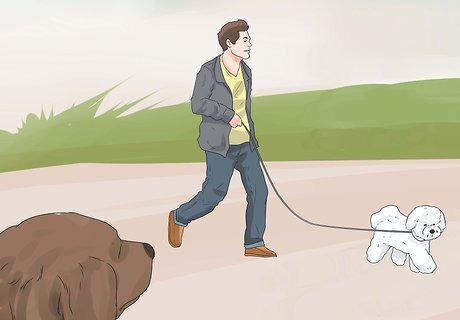
Walk away from the other dog. If choosing a different place to walk is not practical, you will need to find different ways to stop your dog’s barking when another dog inevitably comes near. For example, when you see another dog, turn around and start walking away from that dog. If you can, do this before your dog even notices the other dog—do not wait until your dog reacts. Turn your body towards the side of you on which your dog is already standing, giving him a little nudge to turn with you. Teach your dog to turn around on cue. Give your dog a verbal cue (‘turn,’ ‘turn around’) and use a treat to lure him to turn. With enough repetition and reward, your dog will learn this cue. Call your dog’s name to get his attention, then run or walk backwards as you are facing him. This will keep your dog’s attention on you as you are putting space between him and the other dog.
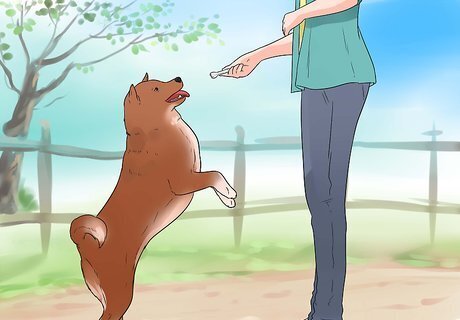
Distract your dog. If you can pull your dog’s attention away from the other dog, he will either stop barking or not be tempted to bark in the first place. One way to distract him is to toss treats on the ground. While the other dog is passing by, your dog will likely be too busy picking treats up off the ground to notice him. You could also bring a squeaky toy with you as a distraction.

Have your dog heel. When another dog is approaching your dog, your dog may be very tempted to lunge at that other dog, as well as bark. Having your dog heel will prevent him from lunging. Give your dog a treat when he heels. Be mindful that your dog may still be tempted to bark, even if you can control his body’s movements.
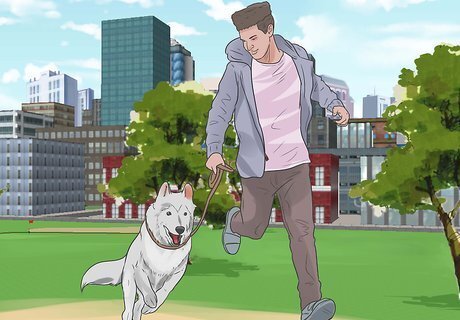
Add challenges to your dog’s walk. Challenges can force your dog to pay more attention to you than other dogs. For example, if you normally walk on a flat street, find a street that has an incline. You could also challenge him by adding unpredictability to your walk: change speed or direction, walk around bushes or trees, or walk up and down on the curb (provided there are no cars passing by). Make the challenge something your dog will enjoy.
Stopping Your Dog’s Barking at Home
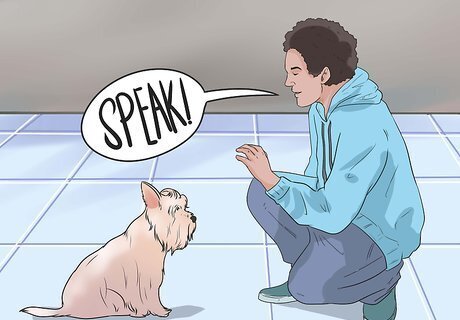
Teach your dog ‘speak’ and ‘quiet’ commands. If your dog barks at other dogs on the home front, you can stop this behavior by controlling when he barks. You will first need to teach him the ‘speak’ command. Say ‘speak,’ then do something that will cause your dog to bark, such as knocking on the door. After he barks a few times, hold a treat in front of his nose and reward him with the treat when he stops barking to sniff it. Once your dog learns to consistently bark when you say ‘speak,’ give him the ‘quiet’ command to stop barking. Hold another treat in front of his nose and give it to him when he stops barking. With practice, your dog will learn to stop barking at other dogs when you say ‘quiet.’ It is best to start teaching the ‘quiet’ command in an area without distractions. You can then practice the command in an area where he is likely to see or hear other dogs. Do not yell 'quiet.' If you yell, your dog will think you're barking too!
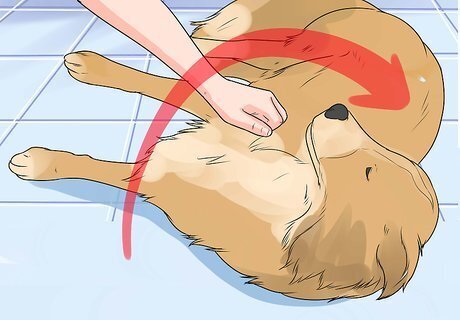
Have your dog perform another activity. The goal here is to have your dog do something that is incompatible with barking. For example, when your dog starts barking, tell him to play dead or roll over. He will not be able to bark in either of these positions. Plus, the effort to actually perform these commands will stop his barking.
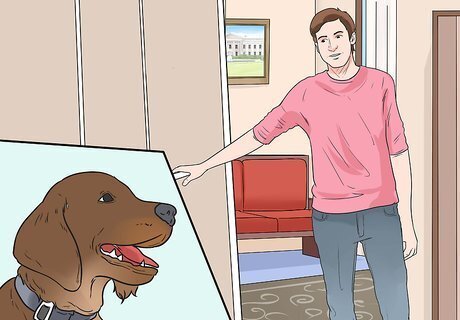
Block your dog’s access. If you have a fenced in yard for your dog, the sight or sound of another dog could trigger barking. You can stop the barking by bringing him inside, thus blocking his access to the other dog. If he’s already inside, you could close the blinds or drapes. If your dog can’t see or hear the other dog, then he won’t have anything to bark at. Your dog may engage in ‘fence fighting,’ in which he runs back and forth along the fence line, barking at another dog to keep him away. This may be fun for your dog, but would not fun for you, the other dog, or the other dog’s owner. Bring him inside if he starts doing this.
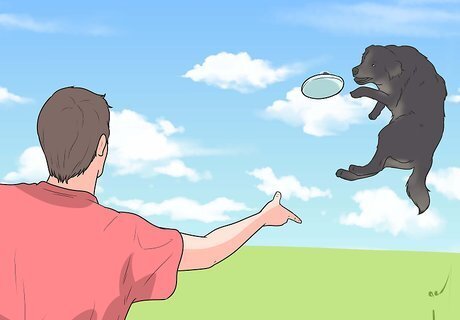
Give your dog something to play with. Just like during walks, distractions can divert your dog’s attention away from the other dog. Food puzzle toys are great distractions, since your dog can focus on them and play with them for long stretches of time. You can also play games with your dog, such as hide and seek or fetch, to keep him distracted.

Turn on ‘white noise.’ White noise is background noise. Although not something your dog would necessarily pay attention to, white noise would help drown out the jingling tags or vocalizations of a dog walking outside. If you notice your dog starting intently at the window and getting ready to bark (if he hasn’t started barking already), turn on some white noise (e.g., television, radio). Noisy tags and vocalizations can be barking triggers. When your dog stops barking, consider giving him a treat to reward him for stopping his barking.

















Comments
0 comment